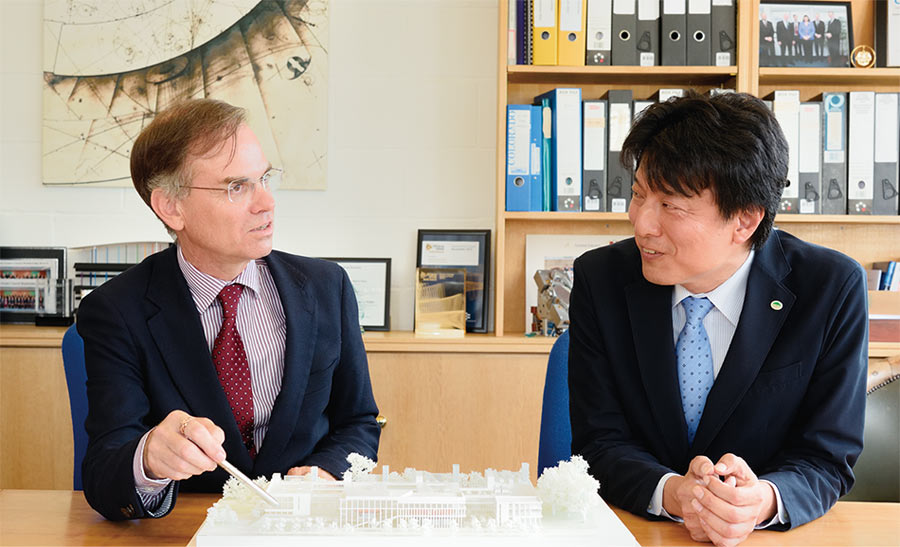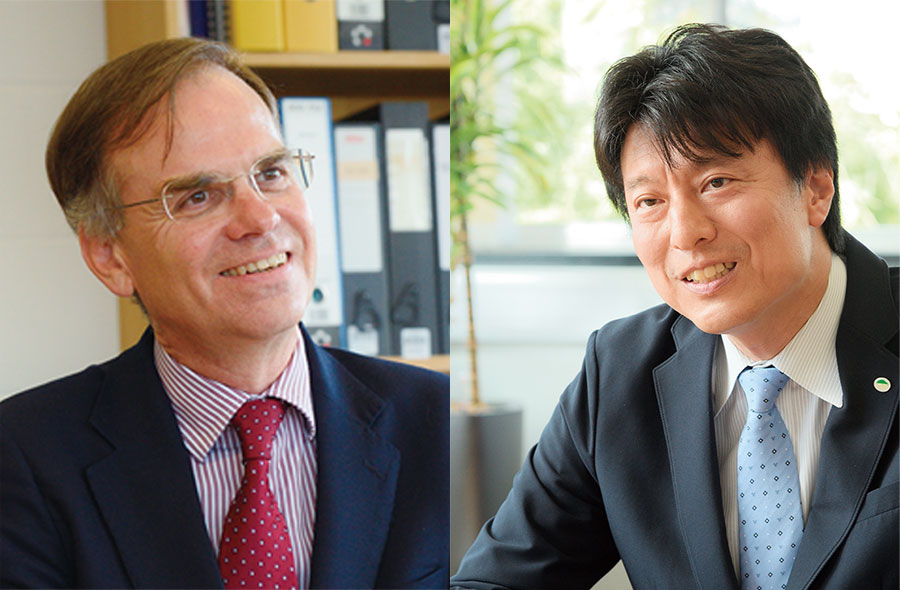Extracting a Signal from All the Noise
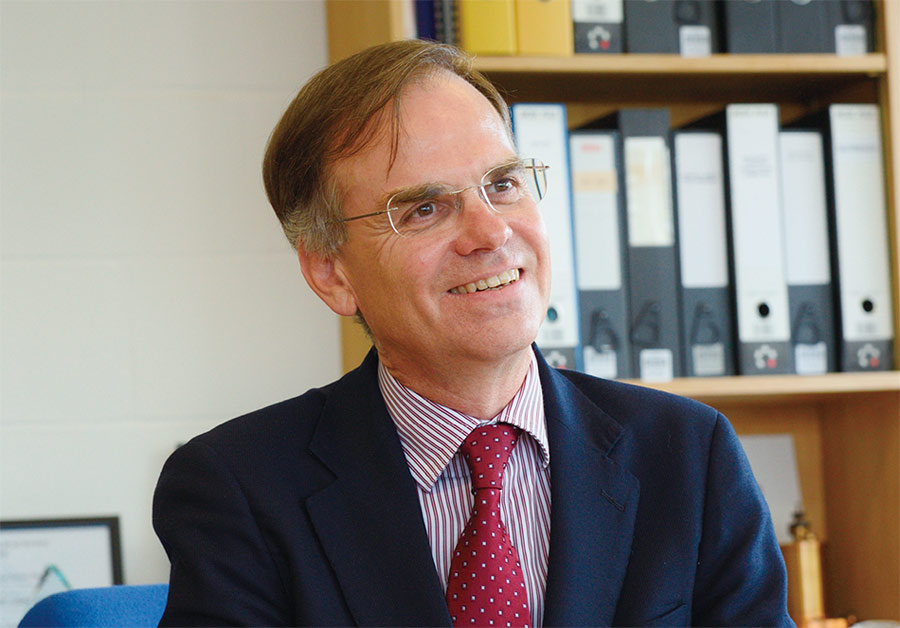 Andy Parker
Andy Parker
Head of the Cavendish Laboratory at the University of Cambridge
Professor Andy Parker is a particle physicist working at CERN on the Large Hadron Collider (LHC), and the Head of the Cavendish Laboratory in Cambridge. He began his career using neutrino beams to explore the structure of the proton, before working on the proton-antiproton collider to explore the properties of the weak interaction. For six years he was the project leader for the particle tracking systems of the ATLAS detector at the LHC, one of the most complex instrumentation projects completed at CERN. In 1989 he moved to Cambridge and led the UK project to build electronics for ATLAS. He was also the Director of the Cambridge eScience Centre, which used big data methods to support interdisciplinary projects across the University. His research interests are in understanding what underlies the “standard model” of particle physics, which encompasses the structure of matter and its interactions. He has particularly focused on testing predictions that new “supersymmetric” particles could be detected at the LHC, and on the theories which invoke extra space dimensions and quantum black holes. He has developed a number of projects to take technology from particle physics into medicine and security applications. He has been the Head of the Department of Physics since 2013 and is responsible for delivering a new Cavendish Laboratory, with construction about to begin. He has recently become a science partner in Ahren Innovation Capital, a new fund focused on breakthrough high technology.
Mori:Many different measurement technologies exist, all of which are vital to visualizing the things we study, and advanced measurement technology is essential to leading-edge science. I have been engaged in research into information and communication technology (ICT) solutions for more than 20 years, with my recent focus being on the application of digital technologies such as the Internet of Things (IoT) to optimization in industry. The ability to observe, assess, and model the real world in quantitative terms is crucial when using digital technologies for optimization, another situation where measurement technology is essential. I expect that measurement also plays an extremely important role in your own work?
Parker:That's right. I am a particle physicist. I started out working on neutrino physics at the European Organization for Nuclear Research (CERN) in Geneva. In fact, the picture on the wall behind me shows a neutrino beam in a bubble chamber. Neutrino physics has advanced in step with our ability to observe the flight path of particles. This use of a bubble chamber to observe particle tracks is one of the earliest techniques and involved considerable time and effort to produce as we manually worked frame by frame through thousands of images.
After coming to the University of Cambridge, I worked on ATLAS (A Toroidal LHC Apparatus) at the Large Hadron Collider (LHC), leading the development of detector systems. The ATLAS detector performs precise measurements of the particles produced by the collision of two proton beams accelerated by the LHC. We have only 25 nanoseconds to measure the thousands of particles emerging from the collision point. It ultimately took us about six years to complete the detector and the electronics that support its operation.
While the ATLAS is still in use at CERN, it is no use just building detectors unless you have the science behind it. The discovery of the Higgs boson provides a classic example. This required extracting a meaningful signal from a huge amount of noise with a signal-to-noise (S/N) ratio of 10-10. That is not something we could have done with bubble chamber photographs.
Mori:In achieving precise detection of particles, it is fair to say that the difficulty lies in identifying what you are looking for given that the signal being detected also contains large amounts of noise.
Parker:That's true. Ways of improving recognition accuracy in noisy systems are extremely important. Humans can tell the difference between what is important and what is not and we are also training computers to use pattern recognition to find the right examples and extract the signal from the noise. Steady progress is being made and I believe it will prove vital to advances in measurement.
New Field Fusing Physics with Biology and Medicine
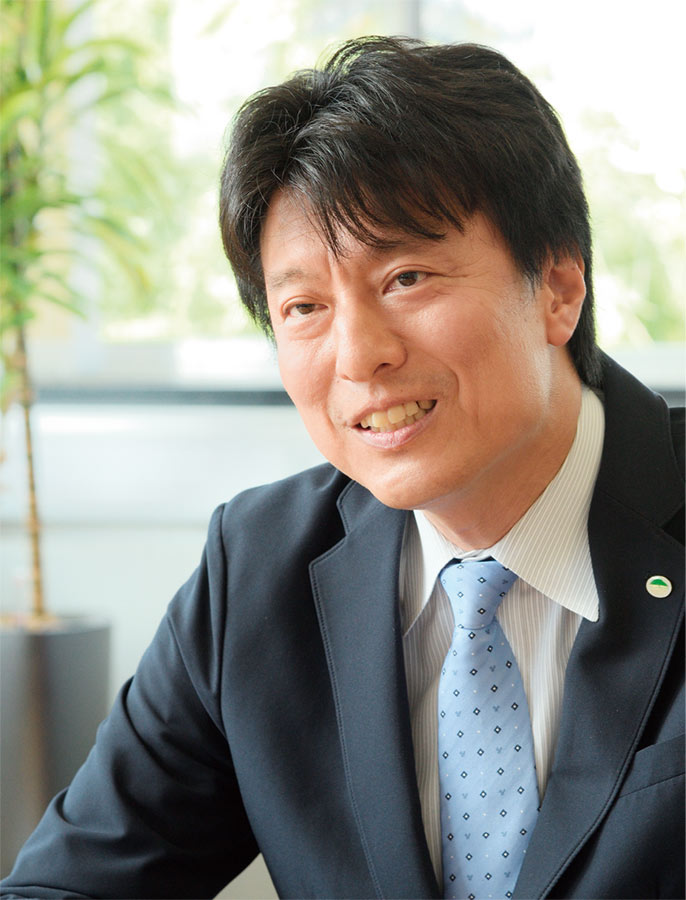 Interviewer
Interviewer
Masakatsu Mori
CTO and General Manager of European R&D Centre, Hitachi Europe Ltd.
Joined Hitachi, Ltd. in 1994. His duties included research into new solutions that utilized advanced ICT, research into production technologies, and research strategy formulation. After some time as a visiting researcher at the University of California, San Diego from 2003 to 2004, he went on to be appointed to his current position in 2018. He is currently engaged in coordinating research and development in Europe, developing the Social Innovation Business, and research and development of advanced technology. He is a member of the Information Processing Society of Japan (IPSJ) and the Society of Instrument and Control Engineers (SICE).
Mori:Along with being a birthplace of physics, the Cavendish Laboratory has also been responsible for producing its fair share of Nobel Prize winners.
Parker:Cavendish Laboratory was originally founded not to do fundamental physics, but to serve industry. Our intention has always been to pursue discoveries that will be useful to society. James Clerk Maxwell is known as a founder of the study of electromagnetism and was the first ever head of the laboratory. The equations he formulated (Maxwell's equations) have served as the basis for a huge outpouring of technologies.
The laboratory had notched up a total of 29 Nobel Prize winners as of 2012. Among those were scientists who laid the foundations of physics, including Professor J. J. Thomson, discoverer of the electron; Ernest Rutherford, who started nuclear physics; and James Chadwick, discoverer of the neutron. The cloud chamber, invented by Charles Thomson Rees Wilson, was the prototype for many detector systems that followed. The well-known discovery by Francis Crick and James Watson of the double helix structure of deoxyribonucleic acid (DNA) involved the use of X-ray scattering to determine material structure, a technique that remains widely used to this day.
Mori:A look back over the history of the Cavendish Laboratory shows that the influence of physics extends into various other fields of study and that it serves as a foundation for industry. The physics of medicine was established as a new field of research in 2008. What was the aim behind that?
Parker:The Cavendish Laboratory has always gone beyond the traditional boundaries between disciplines. The physics of medicine is one such example, combining the different fields of physics on one hand and biology and medicine on the other.
Further progress in biology and medicine will require the ability to make dynamic observations and measurements of what is going on at the molecular level inside living systems. Measurement technologies from physics are also extremely useful for biological processes. Precise and efficient measurements can be made of biological processes by applying such technologies as Raman spectroscopy and micro-fluidics to biological systems. Ideally, this is something you want to do in vivo and technologies that make this possible are now starting to become viable.
So one of our aims with the physics of medicine is to take measurement technologies from physics and apply them to biological problems. Conversely, we also hope to take biological systems and use them to inspire new insights in physics. Examples of such work include DNA origami (the use of DNA to form nano-scale structures) and nano-machines built from molecules. Nano-machines are highly sensitive to chemical concentration and can be targeted exactly at a particular location. Nano photonic devices have the potential to help achieve single-molecule imaging in biological organisms. Many possibilities exist, with the building of structures that act on DNA and using them to make new cells being one example.
Cavendish Laboratory, University of Cambridge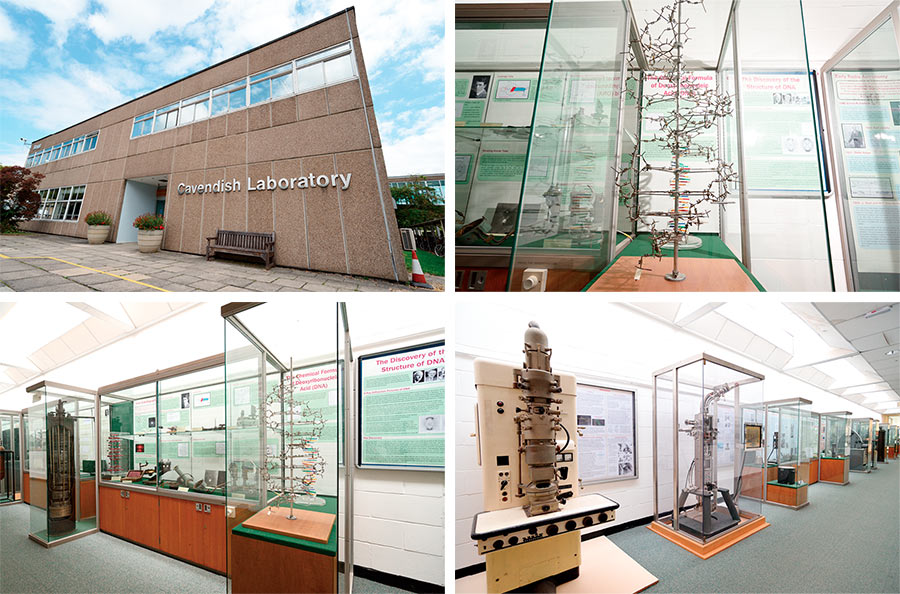 Cavendish Laboratory at the University of Cambridge and some of its research exhibits
Cavendish Laboratory at the University of Cambridge and some of its research exhibits
Relationship of Trust Built up over 30 Years
Mori:When it comes to collaboration, it is not only links between disciplines that are important, but also those between different organizations. The Cavendish Laboratory also includes the Hitachi Cambridge Laboratory (HCL), which was established in 1989 with the aim of conducting fundamental research, and I would like to take this opportunity to thank you for your support over the past 30 years together.
Parker:Likewise, we are delighted to contribute to advances in research.
Mori:The main topics of research have included quantum computers, spintronics, and nanophotonics, and we are also currently exploring new areas. Combining our respective fields of expertise and actively seeking opportunities for discussion in our joint research with the Cavendish Laboratory has given rise to new ideas and research achievements. The presence of students is also very important to us and we have successfully established a relationship of trust that makes Hitachi and the University of Cambridge a model for collaboration between industry and academia. The success of this can be seen in the many articles that have appeared in prestigious journals such as Nature and Physical Review. What is your view on the activities of HCL?
Parker:Collaborations between industry and academia are very important. It is important that university research does not become isolated from society and from the real needs of industry. We don't want the very talented students that we attract here to Cambridge to just sit in a corner of a laboratory separated from the real world. I have kept in contact with industry ever since I was a student and I place a high value on seeing for myself what is going on in everything from fundamental research to practical applications.
Mori:Academia today is characterized by an increasing segmentation and specialization of research fields. Meanwhile, the growing complexity and diversity in the challenges facing society is such that solving them will call for a wide range of multi-faceted resources, including in research know-how, technology, and the people involved. This is boosting the importance of open innovation in which the involvement of industry, universities, and various other interested parties working together is a source of new technologies and ideas. As a symbol of the ongoing partnership between the University of Cambridge and Hitachi, HCL is recognized as a leading example of the open innovation being pursued by research and development at Hitachi. From the university's perspective, what are your hopes and expectations for HCL and Hitachi?
Parker:We also recognize the importance of open innovation. The breaking down of the barriers between disciplines that we spoke of earlier is one way in which we can go about this. To encourage the sharing of knowledge with researchers from participating companies, we built the Maxwell Centre to serve as a hub for collaboration in physics between industry and academia.
Our experience of collaboration with Hitachi over the past 30 years is something that is unique. However much the Internet may have improved communication, it remains important to have a place where people can meet and talk face to face. Having the laboratory located on the university campus provides considerable opportunity for open innovation.
In my experience, intellectual property is the greatest obstacle to open innovation and it is fantastic that we haven't had a single issue with that involving Hitachi. One of the reasons why the University of Cambridge is such a good place to do innovative research is because we take such a liberal approach to intellectual property. What matters to us is that discoveries benefit society by being put to broad practical use. The worst situation is when a discovery cannot be used because of a few pages of document in a safe somewhere. Such outcomes can be avoided if the company and university talk to each other. Communication between people ensures that their fairly held positions can be respected. Maintaining this relationship of trust over the long term is vital. I believe there remain many fields of research waiting to be explored by Cavendish Laboratory and HCL working together.
The Hitachi Cambridge Laboratory (HCL) hosts the work of a number of students.
Measurement Technologies Driving Innovation in Science and Technology
Mori:I hope we can continue working together on research that benefits society. Finally, I would like to ask you about your vision for future research into measurement technologies.
Parker:With regard to measurement, much of our research relates to fundamental physics. To give examples, there is incredible work being done in astronomy that allows us to measure and characterize a single photon that has traveled across space to reach us. The research we hope to pursue in this field includes work on cosmic microwave background polarization that has the potential to tell us about the origins of the universe. Another example that is closer to everyday life is quantum mechanical measurement. This involves measuring the properties of single particles – single atoms or single electrons – that control spintronics devices, work that will ultimately lead to quantum computers. While building reliable quantum systems is no easy task, we are pursuing the technologies needed for this, including working with various semiconductor system and laser optics laboratories on quantum dots.
On the biological side, what I said before about the need for in-vivo measurement systems is very important. Biological systems involve a vast range of molecules interacting in a very complicated way. Chemical gradients within cells, for example, are very important to how biology works. Because these gradients are part of a dynamic process, understanding them requires the continuous measurement of very low levels of particular chemicals in living systems without interfering with them. This requires remote measurement technologies that can be applied to biological systems, including the single-molecule sensing technology that has attracted attention in recent times, as well as positron emission tomography (PET), single-photon emission computed tomography (SPECT), and magnetic resonance imaging (MRI). When used together with devices such as infrared lasers and ultrasound, these technologies enable dynamic measurement of biological processes. Combining this dynamic measurement with the advanced genetic manipulation techniques we now have should open up new possibilities. There is also scope for advances in gene therapy once it becomes possible to measure the effects of genetic manipulation not only at the cellular level, but also throughout the body.
Mori:The search for new discoveries demands measurement technologies that are more precise and accurate than those that have gone before, and this in turn requires more advanced technologies that draw on new knowledge of physics or other subjects. In other words, you could say that measurement technologies are what drive innovation in science and technology.
Parker:I agree. New technologies make new discoveries possible. Many of the Cavendish Laboratory's successes we talked about earlier came about through advances in measurement technology.
Mori:Through its Social Innovation Business, Hitachi seeks to resolve a wide range of societal challenges. As measurement is also important for getting to grips with the problems that confront our society, I believe we need to continue pursuing research aimed at advancing the technology.
One last thing: could you please tell me about your new Cavendish III facility? I understand it is due to be completed in 2021 or 2022.
Parker:That's right. It is a project that I am looking forward to very much. The facility will house around 2,000 people and cater to 800 to 900 undergraduates each year studying not only theory, but also experimental techniques and measurement. Public spaces will include seminar rooms and places where research work can be presented as well as a large coffee room, which is essential for communication. The research building will be split into separate parts with laboratories for particular fields grouped together. Examples include laboratories that deal with low-temperature physics or low-temperature measurement, measurement equipment for laser optics, and separate clean rooms for the assembly of things like inorganic electronics, organic electronics, and detectors. As well as conventional laboratories for things like physics, chemistry, and optics, we also have a large bicycle shed to house all the bicycles that are essential for getting around Cambridge. The UK government has invested £75 million in the project and we in return will be allowing universities across the UK to use the facilities that we have here. We are trying to grow the physics community and to make sure that the money invested flows back to society in the form of greater opportunities for both our university partners and our industry partners.
Mori:I look forward to the completion of this new center of physics. Thank you for your time today.
